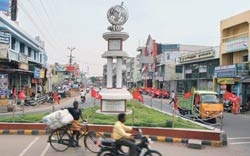
April 4, 2008
Tirupur
It has taken us 90 minutes to reach the outskirts of Tirupur from the Coimbatore airport, about 60 km to the south-west. A journey that would have been an unremarkable drive down Avinashi Road, eventually branching off to places like Bangalore and Mettupalayam (the gateway to the Western Ghats), is literally painted red. Festooned with an assortment of communist flags, buntings and cutouts to celebrate the ongoing CPI(M) conclave being held in the industrial hub, we’re told that we’re lucky to get a taxi at all, since all modes of public transportation have been commandeered for the party conclave.

The rising rupee dealt a body blow to the industry, resulting in a 15-20 per cent decline in export revenues last year. The exporters in this city, mainly focussed on the lucrative US market, were caught completely off-guard. “No one expected the dollar to slump like this. Units like ours had to return to the drawing board and completely rechart our strategy,” says D. Senthil Kumaar, Managing Partner, DSP Knitting Company, which saw its turnover decline from a high of Rs 30 crore to around Rs 7 crore today.

Already, Indian exporters have been edged out of several low-cost segments at the bottom end of the market—China’s scale and infrastructural superiority is adding to their difficulties. “It takes us up to 120 days to deliver a large order.

The dollar downturn apart, the industry seems to have boundless issues to deal with—including a 10-15 per cent increase in raw material prices, especially of cotton yarn, and infrastructure bottlenecks. “We’re fined for operating on Sunday, if we use state power,” moans Kumaar.
Doing its bit for the town, TEA has spent Rs 1,000 crore from its own corpus on basic amenities, including a drinking water system. Now that Tirupur has been declared a district from April 1 this year, it may finally get a much-needed shot in the arm. TEA also has help at hand in the shape of industry-specific solutions, courtesy a tie-up with Microsoft and the National Manufacturing Compet-itiveness Council (NMCC) under Project Vikas, an information communication technology (ICT) project to improve the competitiveness of SMEs across the country. This IT-centric project has multi-pronged scope—from portal redesign to development of webbased ERP solutions and even implementation of e-learning solutions.

“There are 200 large exporters, 150 mid-size companies and 3,000 small contractors here; so the implementation is widespread,” says Sanjay Kumar Gupta, CEO, TEA e-readiness Centre, a swish new facility at the heart of Tirupur that serves as the nerve centre of this tech upgrade.
A key part of this programme will be beefing up the tech skills of thousands of employees of member companies, says Gupta. It also has plans to meet the demand for people once the industry kicks into top gear once again. By June this year, NIFT-TEA Fashion Institute’s Shanmugham hopes to have a Rs 10-crore, 120,000-sq. ft textile training facility ready at Mudalipalayam on the outskirts of Tirupur.
Away from these people issues, Sakthivel and his colleagues are also working on redefining the contours of the local industry. For starters, companies are beginning to move up from ordinary garment manufacture to value-added textiles, which will realise much higher prices.
Next, they are also looking to expand their seasons—graduating from just spring and summer wear to producing heavier autumn and winter collections for their customers. To achieve this, they need to get acquainted with more complex (read: blended) textiles and ensure that they can manage more intricate manufacturing processes.
Finally, vertically-integrated manufacturing appears the way forward, and 40-50 TEA members are already moving to this model and many more are lining up investments to make the transition.
By all accounts, Tirupur’s textile industry appears to have turned the corner. Nonetheless, it’s still waitand-watch on how well the new moves work.